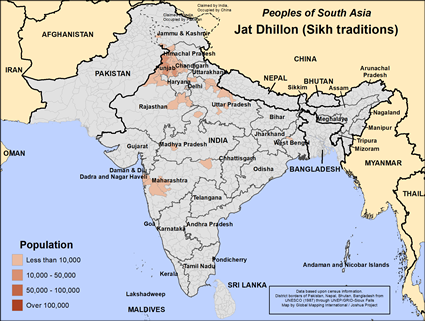Jat Dhillon (Sikh traditions) in India

Photo Source:
Copyrighted © 2026
Isudas All rights reserved. Used with permission |

Map Source:
People Group data: Omid. Map geography: UNESCO / GMI. Map Design: Joshua Project.
|
| People Name: | Jat Dhillon (Sikh traditions) |
| Country: | India |
| 10/40 Window: | Yes |
| Population: | 188,000 |
| World Population: | 188,000 |
| Primary Language: | Punjabi, Eastern |
| Primary Religion: | Other / Small |
| Christian Adherents: | 0.00 % |
| Evangelicals: | 0.00 % |
| Scripture: | Complete Bible |
| Ministry Resources: | Yes |
| Jesus Film: | Yes |
| Audio Recordings: | Yes |
| People Cluster: | South Asia Sikh - Jat |
| Affinity Bloc: | South Asian Peoples |
| Progress Level: |
|
Introduction / History
In India, caste discrimination is forbidden by the constitution, but in actuality it pervades all religious and social structures. Socially, the most elite castes are called "forward castes," and among them are the 12 million Jats. Though most Jats are either Muslim or Hindu, those in the Punjab state are mainly Sikh. Among the Jats, there are sub-groups. The largest group is the Jat Dhillons, often called the Raja Jats due to the large number of kings, royalty, and warriors that have come from their clan. Its history dates back over 4,000 years with an impressive history in clan folklore. The Dhillon Dynasty probably founded India's capital city, Delhi, and ruled there from 800-283 B.C. The city's name is derived from the clan's name.
What Are Their Live Like?
Overall, Jat Dhillons have a good self-image. "Men may come and men may go, but I go on forever," is a well-known Jat proverb. They are brave, hardworking people who possess both the desire and ability to rule. It has been said that no Jat wants to be ruled. Rather, he desires to have power over a group if not over an area. They take great pride in their ancestry. In fact, all the Jats in a particular village consider themselves to be the descendants of the man whom they believe founded it by the power of the sword. Traditionally Jats have dominated as the political class in Haryana and Punjab.
Conservative by nature, Jat Dhillons rarely marry people from other people groups. From about 1650 AD onwards marrying within same gotra (ie, lineage or community) became more common. The modern-day litmus test that Jat people use in marriage is if the girl and boy must not have the same great-great-grandparents (not related for four generations). If they are from the same gotra but are not directly related for four generations then it is considered acceptable for them to marry.
Physically, Jat Dhillons are usually taller and heavier than most of their neighbors. Because of their larger build, their reputation for violence, and the fact that they control much of the land and village income, they are generally feared by other communities in South Asia.
Most Jat Dhillons live in rural areas, and they are usually landowners. A small percentage are traders and laborers. Today, Dhillon Jats are well read, and some occupy high positions in academic and technical arenas. The Jat peoples are one of the most prosperous groups in India on a per-capita basis (Punjab, Haryana, and Gujarat are the wealthiest of Indian states). Haryana has the largest number of rural crorepatis (similar to "millionaires") in India, all of whom are Jats. Ironically, because they value thriftiness and diligence, the Jats are often regarded as miserly.
What Are Their Beliefs?
There is a strong Christian presence in India's Punjab State, home of most members of the Dhillon Jats. A church planting movement began in 2000 and had goals to have strong churches in each of its 12 districts, to have Christian workers based in each of its 491 pincode areas, and for every people group to have a church. Unfortunately, forward castes like the Jats are the least reached and least open to change. Caste is so important, especially in marriage, that some Jats advocate DNA testing to prove "Jatness" before the wedding.
What Are Their Needs?
Many Jat Dhillon communities need clean drinking water and proper health care facilities. Christian medical teams and humanitarian aid workers are needed to work among them and show them God's love in practical ways.
Missionaries, Christian broadcasts, and evangelistic literature are needed to effectively reach the Jats with the light of the gospel. Most importantly, they need people who will begin to intercede for them, tearing down the strongholds that are keeping them in spiritual bondage. Only then will their hearts be prepared to receive the good news as it is presented to them.
Prayer Points
Pray that Jat Dhillons people will have a spiritual hunger that will drive them to seek and find Jesus Christ.
Ask the Lord of the harvest to send out laborers filled with the power and the fruit of the Holy Spirit to serve the Jat Dhillons.
Ask God to save key Jat Dhillon leaders who will begin a Disciple Making Movement among their people in the 2020s.
Pray for Jat Dhillon leaders to recognize the blessings that Christ offers their families and communities.